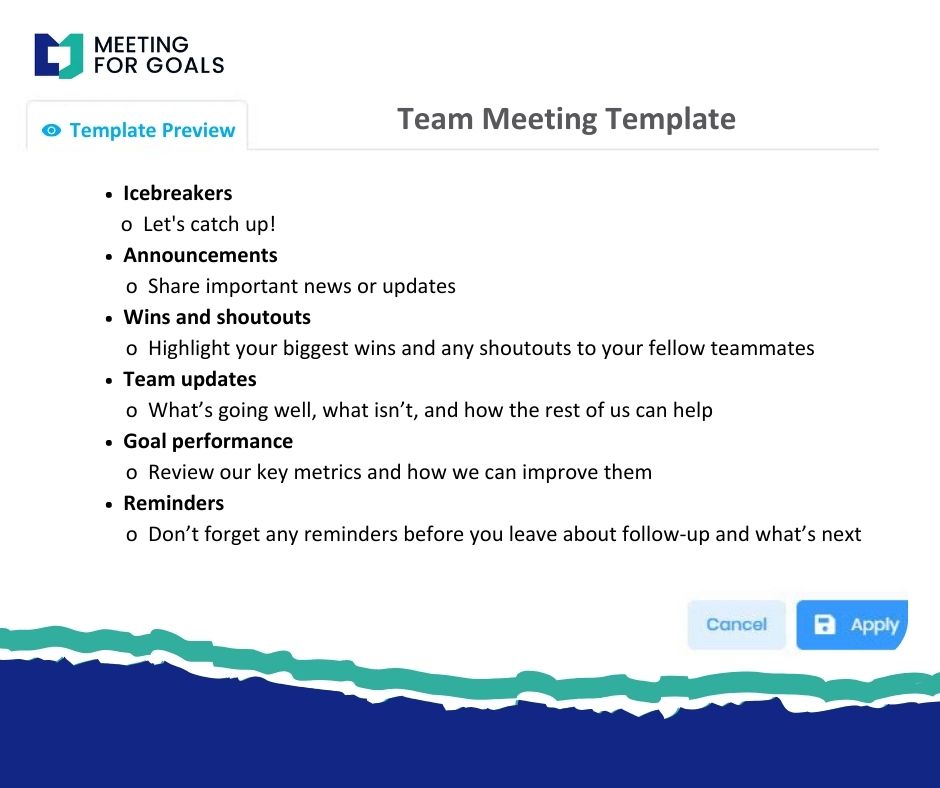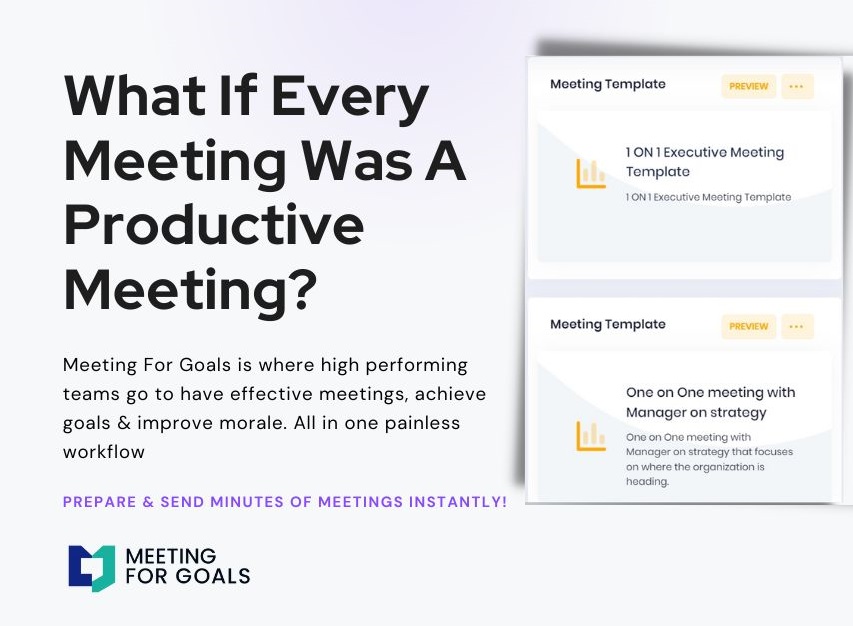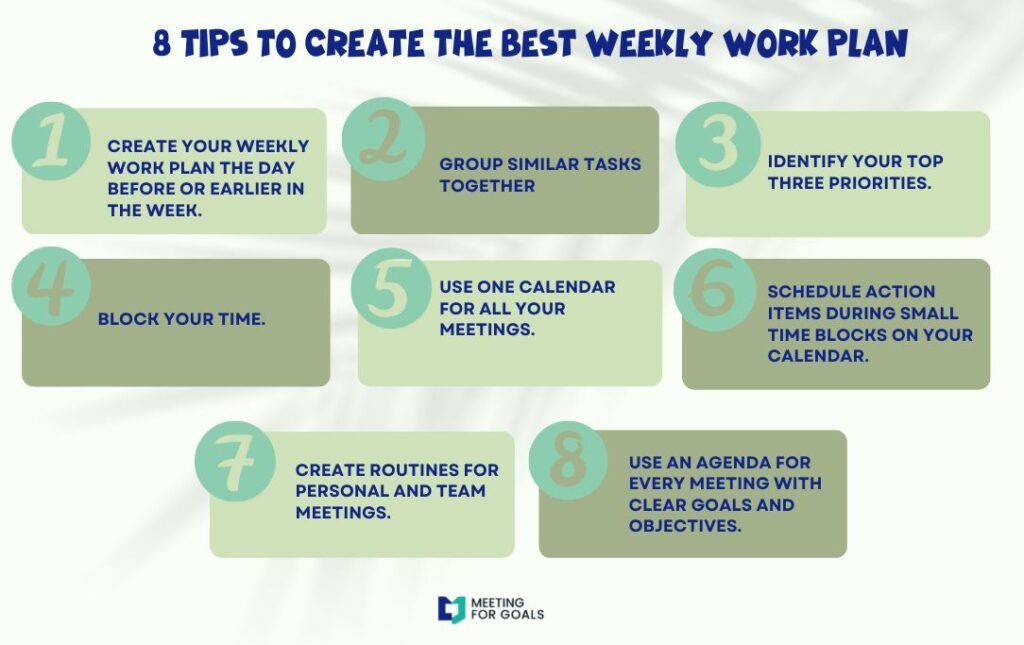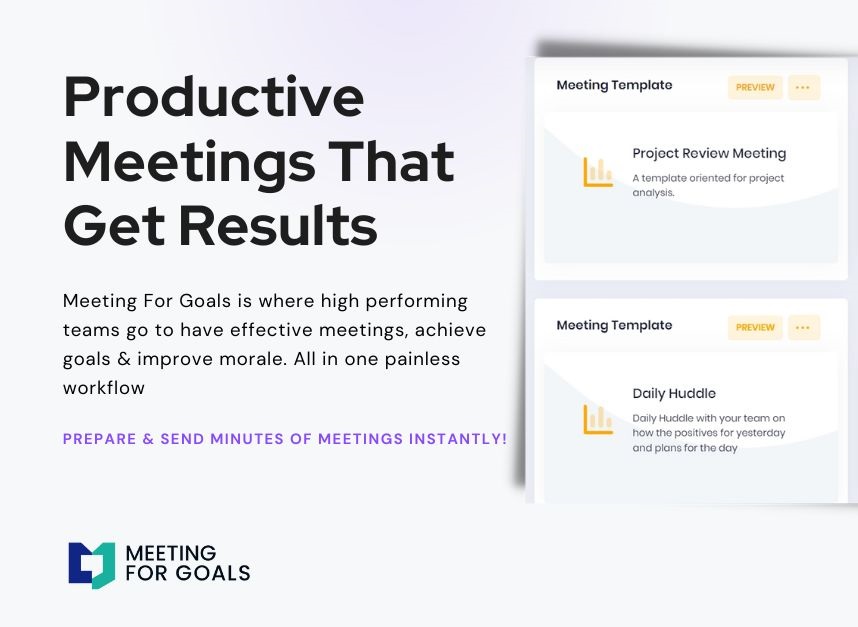Note Taking and Note Making: The Secret to Productive Meetings for High-Performing Teams
In today’s fast-paced business environment, effective meetings are no longer a luxury—they’re a necessity. For high-performing teams aiming to align with company goals, boost accountability, and save valuable time, mastering the skills of note-taking and note-making can be a game-changer.
If you’re ready to level up your meetings, start by exploring our free meeting templates and sign up at Meeting For Goals to experience how structured meetings can transform your team’s productivity.
I. Introduction
Meetings are the heartbeat of collaboration in any organization, especially for companies with 40 to 70 employees. When run well, they:
- Foster alignment
- Clarify direction
- Accelerate progress
But when poorly managed, meetings can quickly spiral into unproductive time sinks filled with confusion and missed opportunities.
That’s where note-taking and note-making come in. These two practices, while often used interchangeably, actually serve very different purposes:
- Note-taking is the act of capturing important points during the meeting.
- Note-making, on the other hand, is what happens after the meeting. It’s the process of processing, organizing, and turning those notes into clear action steps.
For leaders like Directors, VPs, and C-suite executives, understanding and implementing both practices can dramatically improve team performance. With a smart meeting management platform like Meeting For Goals, these practices become second nature, helping you align every meeting with your company’s strategic goals.
In this article, we’ll break down the differences between note-taking and note-making, share best practices, and show you how to integrate these skills into your team’s workflow. Whether you’re leading quarterly planning or daily stand-ups, these strategies will help your team stay focused, organized, and results-driven.
2 Minute Video
Watch a 2 minute demo of our meeting management software in action
II. Understanding Note Taking
Note-taking is the real-time act of writing down what’s happening during a meeting. It’s about capturing key points, decisions, action items, and important details. Think of it as your team’s memory—it ensures nothing critical gets lost in the shuffle.
Benefits of Note Taking in Meetings:
- Capturing Key Information and Action Items:
In fast-paced meetings, details can fly by. A good note-taker ensures that decisions, tasks, and deadlines are all recorded. This makes it easy to follow up and keeps everyone on the same page. - Improving Focus and Retention:
Writing things down helps people remember them better. Well-organized notes also allow team members to review conversations later and stay aligned with the team’s direction. - Promoting Transparency:
When notes are shared with the team, everyone gains visibility into what was discussed—even if they weren’t in the room. This builds trust and improves communication.
Techniques for Effective Note Taking:
- The Cornell Method: Divide your page into three sections—cues, notes, and summary. This helps you organize thoughts and review key points later.
- Mind Mapping: Create visual diagrams to connect ideas. Great for brainstorming sessions or complex discussions.
- Bullet Journaling: Use short phrases and symbols to quickly log information. Ideal for fast-moving meetings.
Want to simplify your note-taking process? Meeting For Goals lets you take notes directly in your agenda, assign tasks in real time, and keep everything organized by project or goal.
Tools and Software for Note Taking:
Traditional pen and paper are fine, but digital tools take note-taking to the next level. With platforms like Meeting For Goals, you can:
- Capture notes within your meeting agenda
- Assign action items as you go
- Tag notes by department, project, or strategic goal
- Store and search past meeting notes
This level of organization helps reduce miscommunication and ensures that your team is always aligned.
According to Harvard Business Review, well-run meetings with structured note-taking can significantly reduce time wasted in follow-ups and redundant discussions.
Adding an Agenda
How to add an agenda instantly on Meeting For Goals
III. Understanding Note Making
Note-making is what happens after the meeting ends. It’s the process of reviewing your notes, organizing them, and turning them into something useful. If note-taking is about recording, note-making is about understanding and acting.
The Role of Note Making in Synthesizing Information:
- Creating Insight and Strategy:
Post-meeting, you can look over your notes and start to see patterns. Maybe several people raised the same concern. Maybe a new opportunity emerged. Note-making helps you connect the dots and make informed decisions. - Making Information Digestible:
By summarizing and organizing your notes, you make it easier for others to understand what happened and what needs to happen next. Visual aids like flowcharts or diagrams can help simplify complex ideas. - Driving Action:
The ultimate goal of note-making is to turn discussion into action. That means clearly defining tasks, assigning owners, and setting deadlines.
Strategies for Effective Note Making:
- Group Similar Ideas: Categorize your notes under themes like “Customer Feedback,” “Product Updates,” or “Next Steps.”
- Highlight Action Items: Mark tasks clearly, so they don’t get lost in the shuffle.
- Summarize Discussions: Create a brief summary of each topic discussed to make it easier for stakeholders to review.
Meeting For Goals makes note-making seamless. You can turn notes into tasks, assign them to team members, and link them directly to your company’s goals or OKRs.
Want a head start? Check out our free meeting templates to see how structured agendas and note-making can change the game.
IV. The Synergy Between Note Taking and Note Making
Note-taking and note-making are two sides of the same coin. When used together, they create a powerful system for capturing, processing, and acting on meeting information.
How Note Taking Leads to Effective Note Making:
Think of note-taking as collecting raw materials—facts, decisions, ideas. Note-making is the process of refining those materials into something useful.
Example: In a marketing strategy meeting, the note-taker records all the campaign ideas and feedback. After the meeting, the note-maker organizes the ideas into themes, prioritizes them based on budget and ROI, and creates a clear plan of action.
Transitioning from Raw Notes to Actionable Insights:
The real magic happens when you move from “what was said” to “what needs to happen.” That’s where Meeting For Goals shines. It helps you:
- Turn notes into tasks with due dates and owners
- Connect notes to company goals and KPIs
- Share summaries with stakeholders for accountability
Real-World Example:
Let’s say your leadership team just wrapped up a quarterly planning session. The note-taker captured key metrics, competitor insights, and internal challenges. The note-maker then creates a SWOT analysis, outlines next steps, and assigns initiatives to team leads. All of this is entered into Meeting For Goals, where it’s tracked and aligned with your strategic objectives.
This process turns meetings from passive discussions into engines of execution.
According to Forbes, companies that document and act on meeting outcomes are significantly more likely to hit their strategic targets.
V. Best Practices for Teams Using Meeting For Goals
Meeting For Goals is built to make note-taking and note-making easy and impactful. Here’s how your team can get the most out of it.
Features That Make Note-Taking Seamless:
- Integrated Agenda and Notes: Keep your notes tied to the agenda for better context.
- Real-Time Collaboration: Multiple team members can contribute to notes at the same time.
- Smart Tagging and Search: Find what you need fast using keywords, goals, or project tags.
Aligning Notes with Company Goals:
Every note you take can be linked to a company objective. This ensures that every meeting is a step toward your strategic vision. Executives love this feature because it provides instant visibility into how meetings support long-term goals.
Encouraging Collaboration and Accountability:
When notes are shared, everyone knows what was discussed and who’s responsible for what. Meeting For Goals also sends reminders for action items, so nothing slips through the cracks.
Saving Time and Reducing Redundancy:
With everything documented and accessible, your team spends less time clarifying and more time doing. No more “what did we decide?” emails or duplicate meetings. Internal communication becomes streamlined, and execution becomes faster.
VI. How to Get Started
If you’re new to structured note-taking and note-making, don’t worry—it’s easier than you think. Start small by:
- Using a consistent format for meeting notes
- Assigning a note-taker for each meeting
- Setting aside 10 minutes post-meeting for note-making
- Reviewing notes as a team to ensure alignment
Then, take it a step further by using a platform like Meeting For Goals. Our tools are designed to help you capture, organize, and act on meeting information without the hassle.
Want to see how it works? Sign up here and experience how Meeting For Goals can transform your meetings.
VII. Conclusion
Effective meetings aren’t just about talking—they’re about capturing, understanding, and acting on what’s said. That’s why mastering both note-taking and note-making is so important.
By capturing key information during meetings and turning it into actionable insights afterward, your team can stay aligned, accountable, and focused on results.
For leaders managing teams of 40–70 employees, these practices are essential. They help reduce confusion, improve communication, and drive measurable outcomes. With the right tools, implementing them is easy.
Meeting For Goals is your partner in this journey. From integrated agendas to real-time collaboration and goal alignment, we provide everything you need to make your meetings matter.
Ready to take your meetings to the next level? Explore our free meeting templates to get started or sign up now to see how Meeting For Goals can help your team stay focused, aligned, and productive.
External Resources:
- Learn more about the science of note-taking from the University of Michigan’s Learning Center: https://lsa.umich.edu/sweetland/student-landing/writing-guides/note-taking.html
- Explore how effective meeting habits impact productivity in this article from McKinsey & Company: https://www.mckinsey.com/capabilities/people-and-organizational-performance/our-insights/the-organization-blog/how-to-run-meetings-that-are-actually-useful
Internal Links Recap:
- Sign up to Meeting For Goals: https://app.meetingforgoals.com/TenantRegistration/Register
- Explore free meeting templates: https://meetingforgoals.com/meeting_templates
- Learn more about our platform: https://meetingforgoals.com
Word Count: Approximately 2,050 words.




